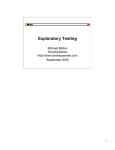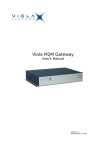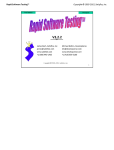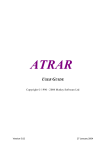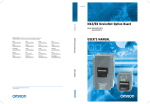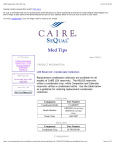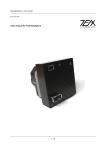Download Basics of Secure Software Design, Development and Test
Transcript
2 Agenda Basics of Secure Software Design, Development and Test Who? Trustworthy Computing Security Development Lifecycle Secure Design Tenets Threat Models Michael Howard [email protected] Senior Security Program Manager Security Engineering Group & Comms Microsoft Corp. Microsoft Confidential Security Testing Coding Issues Last update: 8-Feb-2005 Copyright Microsoft Corp. 2004 3 The Security Engineering & Communications Group 4 Security Development Lifecycle Help you secure your products “Security-as-in-threats” NOT “Security-as-in-crypto” mailto:switeam http://swi http://msnsecurity/sdl Copyright Microsoft Corp. 2004 Copyright Microsoft Corp. 2004 1 5 6 A Case Study: MS04-011 Early Results of the SDL 55 VULNERABILITY IDENTIFIERS IMPACT OF VULNERABILITY WINDOWS 2000 WINDOWS XP WINDOWS SERVER 2003 LSASS Vulnerability - CAN-2003-0533 Remote Code Execution Critical Critical Low LDAP Vulnerability – CAN-2003-0663 Denial Of Service Important None None PCT Vulnerability - CAN-2003-0719 Remote Code Execution Critical Important Low Winlogon Vulnerability - CAN-2003-0806 Remote Code Execution Moderate Moderate None Metafile Vulnerability - CAN-2003-0906 Remote Code Execution Critical Critical None Help and Support Center Vulnerability - CAN-2003-0907 Remote Code Execution None Critical Critical Utility Manager Vulnerability - CAN-2003-0908 Privilege Elevation Important None None Windows Management Vulnerability - CAN-2003-0909 Privilege Elevation None Important None Local Descriptor Table Vulnerability - CAN-2003-0910 Privilege Elevation Important None None H.323 Vulnerability* - CAN-2004-0117 Remote Code Execution Important Important Important Virtual DOS Machine Vulnerability - CAN-2004-0118 Privilege Elevation Important None None Negotiate SSP Vulnerability - CAN-2004-0119 Remote Code Execution Critical Critical Critical SSL Vulnerability - CAN-2004-0120 Denial Of Service Important Important Important ASN.1 “Double Free” Vulnerability - CAN-2004-0123 Remote Code Execution Critical Critical Critical Critical Critical Critical Aggregate Severity of All Vulnerabilities 17 Code fixed in Windows Server 2003 (50%) Code not fixed in Windows Server 2003 (50%) Copyright Microsoft Corp. 2004 Extra Defense in Windows Server 2003 (29% of 455 ) Copyright Microsoft Corp. 2004 7 Secure Design Reduce Attack Surface Defense in Depth Least Privilege Secure Defaults Copyright Microsoft Corp. 2004 8 Defense in Depth (MS03-007) Windows Server 2003 Unaffected The underlying DLL (NTDLL.DLL) not vulnerable Code fixed during the Windows Security Push Even if it was vulnerable IIS 6.0 not running by default on Windows Server 2003 Even if it was running IIS 6.0 doesn’t have WebDAV enabled by default Even if it did have WebDAV enabled Default maximum URL length (16kb) prevented exploitation (>64kb needed) Even if the buffer was large enough Process halts rather than executes malicious code, due to buffer-overrun detection code (-GS) Even if it there was an exploitable buffer overrun Would only ‘network service’ privileges – commensurate with a normal user Copyright Microsoft Corp. 2004 2 9 Least Privilege Problem Definition 10 Least Privilege Not being an administrator helps ensure users cannot easily compromise a computer or the network Don’t just run as admin so stuff works The #1 ask of IT administrators interested in increased security and reducing TCO Look at Network and Local Service Don’t write user data to HKLM, C:\Program Files or %windir% Attacker’s stuff works too! Increased reliability Attractive to Abby, as it improves computer security and parental controls “We strongly recommend that compromised hosts be taken off line and completely rebuilt, including a fresh install of the operating system and application of all relevant patches.” Use HKCU or %userprofile% Part of the spyware issue Don’t open resources for ALL_ACCESS Copyright Microsoft Corp. 2004 Copyright Microsoft Corp. 2004 11 Secure Defaults Less code running by default = less stuff to attack by default 12 Attack Surface Reduction (ASR) Ideas TCP/UDP Slammer & CodeRed would not have happened if the features were not enabled by default Reduces the urgency to deploy security fixes TCP/UDP A ‘critical’ may be rated ‘important’ TCP/UDP Defense in depth removes single points of failure Reduces the need for customers to ‘harden’ the product Service: Autostart SYSTEM Reduces your testing workload Reduce your attack surface early! Copyright Microsoft Corp. 2004 Copyright Microsoft Corp. 2004 3 TCP only 13 Turn off less-used ports 14 Turn off UDP connections TCP/UDP TCP/UDP TCP/UDP TCP/UDP Service: Autostart SYSTEM Service: Autostart SYSTEM Copyright Microsoft Corp. 2004 Copyright Microsoft Corp. 2004 15 Restrict requests to a small IP range and subnet 16 Authenticate Connections TCP only Service: Autostart SYSTEM Copyright Microsoft Corp. 2004 TCP only Service: Autostart SYSTEM Copyright Microsoft Corp. 2004 4 17 Reduce Privilege and Disable 18 Harden ACLs TCP only TCP only Service: Manual NetService Service: Manual NetService Everyone (Full Control) Admin (Full Control) Everyone (Read) Service (RW) Copyright Microsoft Corp. 2004 Copyright Microsoft Corp. 2004 19 20 Increased Attack Surface means Increased Security Scrutiny… • On by default • Running as SYSTEM • Open, unauth TCP socket Copyright Microsoft Corp. 2004 Design Checkli ! Und st ers to you tand the SD ! L – it app lies ! Red uce att ack su ! Redu rface ce atta ck surf ace EA RLY! • Off by default • Running with least priv • Open, TCP socket limited to local subnet Copyright Microsoft Corp. 2004 Every industrone in the do this y should securi ty stuff 5 21 Threat Analysis 22 A Threat Modeling Process Gather Background Info Secure software starts with understanding the threats Threats are not vulnerabilities Threats live forever, they are the attacker’s goal(s) • Use-scenarios • Bound scope • Determine dependencies Model the System • Data flow diagrams • Identify entry points & assets • Determine threat paths Asset Mitigation Threat Spoofing Tampering Repudiation Information Disclosure Denial of Service Elevation of Privilege Identify Threats • Threat type (STRIDE) • Threat Trees • Risk • • • • Vulnerability Copyright Microsoft Corp. 2004 Copyright Microsoft Corp. 2004 Fix? Work-around? Notification? Do nothing? Copyright Microsoft Corp. 2004 23 Context Diagram Services for Macintosh Resolve Threats 24 Level-0 DFD Services for Macintosh Copyright Microsoft Corp. 2004 6 25 Level-1 DFD Services for Macintosh (File) 26 Determining Threat Types TID SR 1.0 6.0 TID 5.0 TID 7.0 STRI DE TID 8.0 10.0 STRI DE SR 2.0. Each element in the DFD is susceptible to one or more threat types TID 11.0 9.0 TID 4.0 STRI 3.0DE Copyright Microsoft Corp. 2004 Copyright Microsoft Corp. 2004 27 DFD Elements are Threat Targets A “Work list” 28 Threat Tree Format Each " is a potential threat to the system. Threat ‘And’ clause Condition Condition ‘Or’ clause Each threat is governed by the conditions which make the threat possible Condition Condition Copyright Microsoft Corp. 2004 Condition Condition Condition Copyright Microsoft Corp. 2004 7 29 Threat Tree Pattern Examples 30 Threat Tree Pattern Examples Spoofing Thinking Like a Security Pro! Copyright Microsoft Corp. 2004 Copyright Microsoft Corp. 2004 31 A Special Note about Information Disclosure threats All information disclosure threats are potential privacy issues. Raising the Risk. Is the data sensitive or PII? 32 Calculating Risk with Numbers DREAD etc. Very subjective Often requires the analyst be a security expert On a scale of 0.0 to 1.0, just how likely is it that an attacker could access a private key? Where do you draw the line? Do you fix everything above 0.4 risk and leave everything below as “Won’t Fix”? Copyright Microsoft Corp. 2004 Copyright Microsoft Corp. 2004 8 33 Calculating Risk with Heuristics 34 Mitigation Techniques Simple rules of thumb Derived from the MSRC bulletin rankings Threat Spoofing Tampering Repudiation Information Disclosure Denial of Service Elevation of Privilege Mitigation Feature Authentication Integrity Nonrepudiaton Confidentiality Availability Authorization Attend “Secure Design Principles” Copyright Microsoft Corp. 2004 Copyright Microsoft Corp. 2004 35 Code Review and the DFD 36 Testing Threats Review code and data on the anonymous data flows, the threat path – this is where the bad guys go – they follow the line of least-resistance. How to test Anonymous Priv Remove anonymous data paths with authentication User Priv Copyright Microsoft Corp. 2004 What needs testing Copyright Microsoft Corp. 2004 9 37 Thre a t M odel C h ! No d ecklist es threat ign is comple model! te with out a ! Follo w anon ymous ! Eve data p ry thre aths at need plan s a sec urity te ! Chec st k threats all informati on dis – are th clo ey priv ! Be w acy isssure ary of ues? elevate ! Use d proces the thre ses at mod eling to vuln ol threa t Security Testing asset Copyright Microsoft Corp. 2004 Microsoft Confidential 39 Security Testing Actual software functionality Traditional faults Unintended, undocumented or unknown functionality Intended functionality Missing Defenses No authn Copyright Microsoft Corp. 2004 Poor Defenses Weak authn 40 Testing Like an Attacker ‘Footprint’ the application ! Extra ‘functionality’ BO in authn Copyright Microsoft Corp. 2004 10 41 The Nature of Fuzzing 42 Fuzz the data! Container Name (On) Link to other (Ol) Exists (Oe) Does not exist (Od) No access (Oa) Restricted Access (Or) Network Replay (Nr) Out-of-sync (No) High volume (Nh) Copyright Microsoft Corp. 2004 Name/Contents Length (Cl) Random (Cr) NULL (Cn) Zero (Cz) Wrong type (Cw) Wrong Sign (Cs) Out of Bounds (Co) Valid + Invalid (Cv) Special Chars (Cp) Script (Cps) HTML (Cph) Quotes (Cpq) Slashes (Cpl) Escaped chars (Cpe) Meta chars (Cpm) Length Long (Ll) Small (Ls) 0-Length (Lz) Copyright Microsoft Corp. 2004 43 Attack Ideas Rule #1 – There are no rules Attacks by admins are uninteresting If you provide a client to access the server, don’t use it! Mimic the client in code If you rely on a specific service build a bogus one 44 “Bang for the Buck” Attack Ideas Consume files? Try device names and ‘..’ Look for: hangs, access to other files Fuzz data structures Look for: AVs or memory leaks (appverifier) Look for PII data in information disclosure threats ActiveX (especially Safe For Scripting) Look at each method/property and ask, “what could a bad guy do” Copyright Microsoft Corp. 2004 Copyright Microsoft Corp. 2004 11 45 46 “Bang for the Buck” Attack Ideas Securit Pushing data from low-priv to high-priv process Admin: Full Control Everyone: Read SYSTEM y Testing ! Build Checkli fu resourc zzers for all st co es (file etc.) s, net p nsumed rotoco ! Tools ls ! Tools ! Tools ! Look for privilege elevation boundaries Everyone: Write ! zz Fu Copyright Microsoft Corp. 2004 Copyright Microsoft Corp. 2004 12














